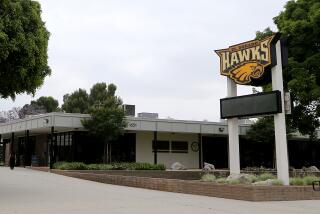Students Worm Out of Dissection
Increasing numbers of students are asking to opt out of the science class ritual of dissecting frogs or fetal pigs, branding the practice cruel and insisting that they can learn as much from computer simulations.
A 16-year-old honor student was removed from her Baltimore anatomy class recently after refusing to dissect a cat, then allowed back in -- with the option of computer alternatives -- after protesters picketed the school.
In Las Vegas, the Clark County school board voted this year to let students opt out of dissections if they have parental support. The policy was adopted after a petition drive by eighth-grader Laurie Wolff, an A student who received a C in science two years earlier after declining to cut up an earthworm.
Anti-dissection students also appealed for policy changes this year at a school board meeting in Little Chute, Wis., and last year before a state Senate committee in Vermont.
Little Chute student Amy Richards gave a practical reason for accommodating the dissenters. âThey wonât learn much with their eyes closed because theyâre disgusted,â she said.
A student delegation from Woodstock Union High School in Vermont helped get a bill introduced to allow students to use computer models. The bill died in the Senate Education Committee.
National teachersâ groups maintain that dissections are a better learning tool than simulations, but suggest instructors be sensitive to student qualms.
According to the Humane Society of the United States, eight states have approved opt-out policies -- California, Florida, Illinois, Louisiana, Maine, New York, Pennsylvania and Rhode Island. A similar policy is pending in New Jerseyâs legislature.
The Baltimore case illustrates how quickly a teacherâs decision can become the focus of ideological controversy.
On Sept. 23, Jennifer Watson was taken out of her Kenwood High honors anatomy class and placed in a general science class after she asked for an alternative to cat dissection. The next evening, Humane Society officials attended a school board meeting, asking that dissection alternatives be provided districtwide.
The following day, about 20 protesters picketed outside Kenwood High, and school officials announced that Jennifer would be allowed back in her class. She will perform computer-simulated dissections, while the rest of the class dissects cats.
âIâve loved animals my whole life,â said Jennifer, whose family has several cats. âI was standing up for what I believe in.â
The Humane Society estimates that 6 million animals -- mostly frogs, fetal pigs and cats -- are dissected annually in American schools. The society distributes anti-dissection videos and lends computer software to schools interested in offering alternatives.
Lesley King, the Humane Societyâs director for education and animal welfare, said school districts can save money by purchasing reusable dissection software rather than dead animals that can only be dissected once.
The 9,000-member National Assn. of Biology Teachers is wary of the push for alternatives. Although it urges teachers to be sensitive to studentsâ objections, its formal position says: âNo alternative can substitute for the actual experience of dissection.â
âThis is an issue of academic freedom,â said Wayne Carley, association executive director. âA well-trained teacher has the knowledge and experience to know how best to use dissection.â
The National Science Teachers Assn., which claims 53,000 members, also defends dissection but advises teachers to be flexible.
âThere were few suitable alternatives when I taught, but now there are some extremely sophisticated virtual technologies,â said Wendell Mohling, a former biology teacher in Shawnee Mission, Kan., who is associate executive director of the science teachersâ group.
More to Read
Sign up for Essential California
The most important California stories and recommendations in your inbox every morning.
You may occasionally receive promotional content from the Los Angeles Times.










